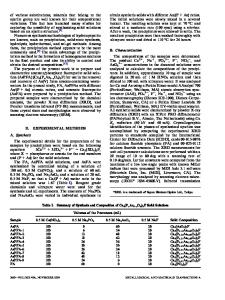Synthesis and characterization of biodegradable AZ31/calcium phosphate glass composites for orthopedic applications
- PDF / 2,119,282 Bytes
- 12 Pages / 595.276 x 790.866 pts Page_size
- 92 Downloads / 302 Views
ORIGINAL RESEARCH
Synthesis and characterization of biodegradable AZ31/calcium phosphate glass composites for orthopedic applications Sahar Mokhtari 1 & Bijan Eftekhari Yekta 2 & Vahak Marghussian 2 & Pooya Torab Ahmadi 2 Received: 14 March 2020 / Revised: 15 August 2020 / Accepted: 3 September 2020 # Springer Nature Switzerland AG 2020
Abstract The advent of biodegradable implants is one of the greatest achievements in the healthcare industry; however, practical drawbacks have hindered their initial stunning progress. Fabrication of ceramic-metal composites partially improves the performance of these medical devices. In this research, AZ31-calcium phosphate glass composites with different glass contents (0–15 wt.%) were synthesized via the powder metallurgy route. The results demonstrated that increasing the glass particle content improved microhardness and compressive strength up to 40% and 50%, respectively. Moreover, corrosion resistance to the SBF solution was reduced and the cell viability of AZ31-calcium phosphate glass composites was increased considerably by the addition of glass particles, based on MTT assay. Eventually, higher biocompatibility and appropriate cell attachment in the composite containing 15 wt.% glass indicated that AZ31-calcium phosphate glass composite has a great potential for using as orthopedic biodegradable implants. Keywords Bio composite . AZ31-glass . Biodegradable implant
1 Introduction Over a decade ago, magnesium-based materials have drawn great attention for use in biodegradable orthopedic applications regarding their outstanding advantages over other metallic biomaterials [1–3]. Biocompatibility and good mechanical properties make magnesium alloys as promising candidates for the development of orthopedic implants [4, 5]. Its Young modulus that is close to natural bone significantly minimizes the stress shielding effect in bone. Also, its higher compressive strength compared with polymers and its fracture toughness compared with ceramics make the mechanical properties of magnesium alloys unique for load-bearing applications [6]. Besides, the degradation of magnesium and its alloys in physiological conditions provides an intriguing property for use in tissue engineering scaffolds because it is absorbed and substituted by natural bone, thus eliminates the need for * Bijan Eftekhari Yekta [email protected] 1
Kazuo Inamori School of Engineering, Alfred University, Alfred, NY 14802, USA
2
School of Metallurgy and Materials Engineering, Iran University of Science and Technology, Tehran, Iran
subsequent surgery after implantation [7, 8]. Extensive studies conducted on the biological role of dissolved magnesium ions have shown non-toxic and good bone cell attachment, which promotes bone formation in the implant site [9, 10]. The major limitation, restricting widespread use of magnesium-based materials, is their rapid degradation in the high-chloride environment of physiological systems [11–13]. Consequently, the mechanical integrity of the implant is lost before the bone ti
Data Loading...











